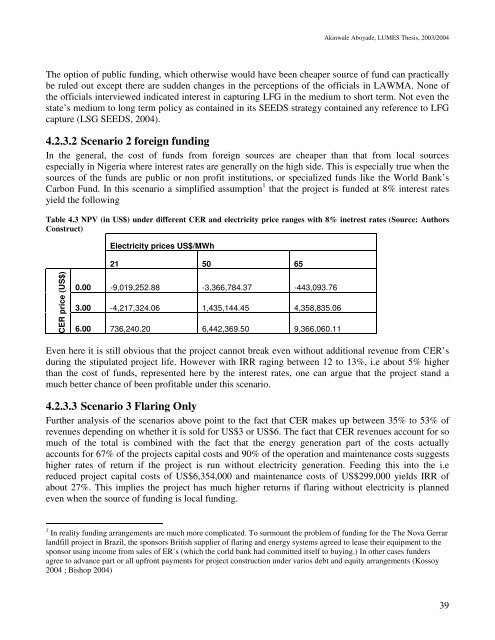Wale Aboyade's thesis - lumes
Wale Aboyade's thesis - lumes
Wale Aboyade's thesis - lumes
You also want an ePaper? Increase the reach of your titles
YUMPU automatically turns print PDFs into web optimized ePapers that Google loves.
Akinwale Aboyade, LUMES Thesis, 2003/2004<br />
The option of public funding, which otherwise would have been cheaper source of fund can practically<br />
be ruled out except there are sudden changes in the perceptions of the officials in LAWMA. None of<br />
the officials interviewed indicated interest in capturing LFG in the medium to short term. Not even the<br />
state’s medium to long term policy as contained in its SEEDS strategy contained any reference to LFG<br />
capture (LSG SEEDS, 2004).<br />
4.2.3.2 Scenario 2 foreign funding<br />
In the general, the cost of funds from foreign sources are cheaper than that from local sources<br />
especially in Nigeria where interest rates are generally on the high side. This is especially true when the<br />
sources of the funds are public or non profit institutions, or specialized funds like the World Bank’s<br />
Carbon Fund. In this scenario a simplified assumption 1 that the project is funded at 8% interest rates<br />
yield the following<br />
Table 4.3 NPV (in US$) under different CER and electricity price ranges with 8% inetrest rates (Source: Authors<br />
Construct)<br />
Electricity prices US$/MWh<br />
21 50 65<br />
CER price (US$)<br />
0.00 -9,019,252.88 -3,366,784.37 -443,093.76<br />
3.00 -4,217,324.06 1,435,144.45 4,358,835.06<br />
6.00 736,240.20 6,442,369.50 9,366,060.11<br />
Even here it is still obvious that the project cannot break even without additional revenue from CER’s<br />
during the stipulated project life. However with IRR raging between 12 to 13%, i.e about 5% higher<br />
than the cost of funds, represented here by the interest rates, one can argue that the project stand a<br />
much better chance of been profitable under this scenario.<br />
4.2.3.3 Scenario 3 Flaring Only<br />
Further analysis of the scenarios above point to the fact that CER makes up between 35% to 53% of<br />
revenues depending on whether it is sold for US$3 or US$6. The fact that CER revenues account for so<br />
much of the total is combined with the fact that the energy generation part of the costs actually<br />
accounts for 67% of the projects capital costs and 90% of the operation and maintenance costs suggests<br />
higher rates of return if the project is run without electricity generation. Feeding this into the i.e<br />
reduced project capital costs of US$6,354,000 and maintenance costs of US$299,000 yields IRR of<br />
about 27%. This implies the project has much higher returns if flaring without electricity is planned<br />
even when the source of funding is local funding.<br />
1 In reality funding arrangements are much more complicated. To surmount the problem of funding for the The Nova Gerrar<br />
landfill project in Brazil, the sponsors British supplier of flaring and energy systems agreed to lease their equipment to the<br />
sponsor using income from sales of ER’s (which the corld bank had committed itself to buying.) In other cases funders<br />
agree to advance part or all upfront payments for project construction under varios debt and equity arrangements (Kossoy<br />
2004 ; Bishop 2004)<br />
39

















